"View" tab
Applies to: viflow (subscription | 9 ) | Article: 2454689 | Updated on 26.04.2024


In the View tab you will find all functions for numbering and sorting processes as well as opening windows and loading layouts.
View group
Button/option |
function |
Notice |
|
Opens the properties window of the selected object. |
Alternatively, can be accessed in the context menu [ |
|
The Explorer window opens. |
Further information can be found in the chapter |
|
Opens the window with the recently edited objects. |
For quickly finding and accessing frequently used functions |
|
The Recycle Bin window opens. |
Information about the objects in the trash can be found in the chapter ››› Using the trash can |
|
Radio buttons for calling up the most important windows: Process Structure, Information, Areas. |
In the standard layout, all three windows are displayed |
|
For selecting all viflow windows including the Overview window. |
Further information about the viflow windows can be found in the chapter |
|
For loading and saving standard and self-defined layouts (views). |
All information about your own layouts can be found in the chapter |
|
With one click you can hide all windows. |
If the windows are hidden, the button is called |
|
For better orientation when modeling, the grid is displayed by default. |
|
|
To change the grid spacing, open the Ruler and Grid window by clicking on the arrow symbol [ |
Task areas – pan and zoom
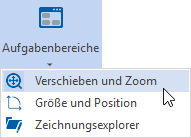
Select this option to open the pan and zoom window. This enables convenient navigation, especially in larger graphics, and allows fine-grained adjustment of the zoom factor by using the slider or the [+] and [-] buttons. To zoom into the process graphic, simply drag an area in the window with the left mouse pointer.
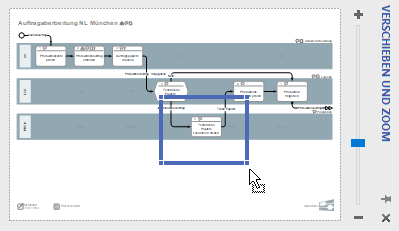
The pan and zoom window can be placed and pinned anywhere on the drawing page.
Responsibilities – size and position
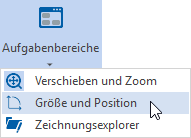
To view the coordinates, width and height of objects on the process graphic, select them and click Size and Position. In the window of the same name, the size properties of the individual objects can be easily changed to specific values.
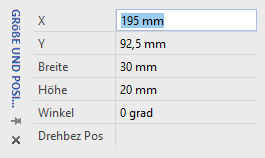
The Size and Position window can be placed and pinned anywhere on the drawing page.
Responsibilities – Drawing Explorer
The Drawing Explorer window can be shown or hidden here. In the drawing explorer you can find all the contents of the process graphics with their technical (Visio) properties.
Zoom group
To set a specific zoom factor in the process graphic, click the Zoom button. The Fit to Window and Drawing Sheet Width buttons are available for quickly adjusting the process graphics.
Visual Support Group
The Dynamic Grid and AutoConnect functions can be activated or deactivated here. Select the Connection points option if you want them to appear in the shapes.
In the Snap and Stick window, the settings for snapping and sticking elements in the graphic can be adjusted. To do this, click on the arrow symbol [  ] at the bottom right of the group.
] at the bottom right of the group.
Main Window group
Switch and arrange windows
If you click Switch Window, you can jump to one of the currently open graphics with one click.
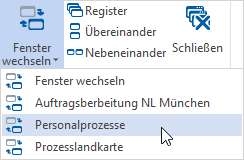
In addition to the standard tab setting , the windows can also be arranged one above the other or next to each other. To do this, click on the Side by Side or Above One Another buttons in the View tab.
Close the window
If you want to close the main windows (e.g. all open graphics), click the Close button in the Main windows group on the View tab.
.png)
Alternatively, you can right-click on the main window tab and from the context menu [.png) ] select one of the following options:
] select one of the following options:
- Close (only this window will be closed)
- Close all main windows
- Close all other main windows (only the current window remains open)
.png)
Layout group
In some windows, different views can be set using the List button. As is known from Windows Explorer, you can choose between different icons, list and detailed views.
.png)
Numbering group
Only process and branch symbols can be numbered in the process graphic. Information and areas are not given a number.
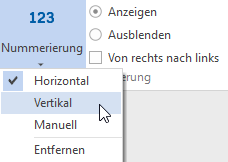
Automatic numbering
By default, the individual process and branch symbols on the drawing page are automatically numbered from left to right and top to bottom.
The following options are available for automatic numbering:
Button/option |
function |
Notice |
 |
Default setting. The numbering is done automatically from left to right and (!) from top to bottom. |
|
|
The numbering is first from left to right and only then from top to bottom. |
Example: The elements in the top swimlane are numbered first, then those in the second, third, etc. swimlane. |
 |
The numbering is removed. | |
|
Hide hides the numbering in the currently displayed graphic, but does not remove it. |
Show is the default setting. |
|
The numbering displayed in the Processes window can be removed by clicking Hide and shown again by clicking Show. |
The Numbering (Tree) group only appears if the Processes window is open and active (click in the window or title bar). |
Manual numbering
If you need a special order of numbers, processes and branches can also be numbered manually:
- Click Numbering – Manual.
The Numbering window appears. - Enter a start number for the first number (default is "1").

- Click on all the processes and branches in the graphic one at a time in the desired numbering order.
- Finish numbering by clicking on the cross at the top right of the Numbering window.


.png)
 ] of an object. The local properties can be accessed by clicking on the arrow in the button.
] of an object. The local properties can be accessed by clicking on the arrow in the button.

















.png)
.png) ] of the window.
] of the window.




